More Odds & Ends: Ravnica Allegiance
Last week, I started answering your questions about Ravnica Allegiance. I had so many good questions that I decided to continue answering more today.

Guilds of Ravnica and Ravnica Allegiance led to the shifting of two evergreen mechanics. Interestingly, one went from black to green, and the other went from green to black. Haste, which was originally primary in red, secondary in black, and tertiary in green has now swapped black and green so that green is now secondary and black is tertiary (used mostly on creatures coming from the graveyard and the occasional creature with something like flying that red and green doesn't do). This change was made because Play Design has needed haste as a tool for green, and the general feeling was it did more for green to have haste than black. Black and red also overlap in menace, so we still had a mechanic for things like black-red hybrid. The reason this came up in Ravnica Allegiance was because of the riot mechanic, which was a bit of a stretch when green was tertiary in haste.
The other swap was flash. Flash used to be primary in blue, secondary in green, and tertiary in white, black, and red. Black got moved from tertiary to secondary with green also staying secondary. We needed an overlap for blue-black, and we realized that black flash could allow us to do some flavorful cards that play a lot like black removal.
The other color philosophy changes are a lot smaller and subtler. We've been experimenting with both red and white to try and find them more abilities that help in the Commander format. Nothing major happened in either Guilds of Ravnica or Ravnica Allegiance, but you can see us experimenting some with cards like Dawn of Hope and Electrodominance.

Bolas's influence is felt within all ten guilds. Yes, he managed to take control (through Planeswalkers) of five of the guilds, but the other five still have pro-Bolas elements within them. Most of the time, we used the legendary creature in the guild that wasn't the leader or Planeswalker to represent the other side within the guild, showing how each guild is struggling within from Bolas's machinations. I'm telling you this because it wasn't our attempt to create red herrings, but rather we wanted to show that no guild is completely free of Bolas's influence.
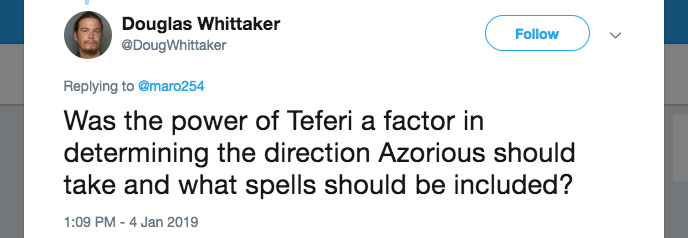
Not at all, and very much. You see, it depends on which part of R&D you're talking about. When Vision Design was working on the file, Dominaria wasn't even out yet, so no, Teferi held very little influence in how we built Azorius from a structural standpoint. In addition, Vision Design is focusing on much larger big-picture issues such that single-card interaction issues aren't usually on our radar. The vast majority of the cards we create in Vision Design, for example, will never see print. Our designs are more proof of concept to help Set Design get a better sense of the vision for the set. That means we are far less focused on the tournament scene of Magic. I should note that we are very conscious of mechanical themes, as they play a major role in crafting new sets.
Play Design, in contrast, is very focused on the impact cards have on tournament play. They have to be aware of cards like Teferi because they have a huge influence on the environment. Also, remember that play design takes place over a year after vision design starts, so that team has a much better view of how the current set is going to fit into the larger play environment. This means that Set Design and Play Design very much had to understand what white and/or blue cards were being played when crafting which elements of Azorius to push for Constructed.
So, did it have an impact? Not at all, and very much.

Let me start by defining the term "deciduous," as it's a term I use a lot on my blog and social media. Mechanics that appear (almost) every set are called "evergreen" (things like flying and haste). Deciduous items are those things which aren't used every set but are available to any designer who wants to use them. For example, hybrid mana, split cards, double-faced cards—these are all tools that are available to any set that needs to use them.
On my blog, I noted that Treasure tokens have become deciduous. Why? Well, they've basically proven to be flavorfully neutral and mechanically useful. Most worlds have treasures of some kind, and most sets can use a token that can be sacrificed for any color of mana. Another important issue is we'd rather reuse the same terms for something than keep renaming it based on the current set. Magic has enough of a learning curve that we don't feel a need for players to learn that multiple different tokens are functionally doing the same thing. We're a bit more willing to vary creature tokens because we often have tribal themes that run through sets which make us want to use a certain 1/1 white creature versus a different one, for example.

Here's how reprints tend to work: Vision Design fleshes out a vision for the set and makes a card file (usually with commons and uncommons filled and enough rares and mythic rares to play Sealed or Draft) as a proof of concept demonstrating the basic structure we're envisioning. Vision Design will also take the first pass at all the mechanics in the set. After designing the cards specifically to play up the mechanics and themes, we usually have a bunch of holes which need to get filled in for playtest. Those holes are often filled in with existing cards, usually things we think have the right feel for the set.
That's how reprints first get into a set, Vision Design using them as a means to help capture the overall look and feel of the expansion. Some of those reprints can stay in the file all the way until print. Many others get removed but are replaced by different reprints. Because reprints are a known quantity, they do a good job of communicating the feel we're aiming for.
Another thing that can happen in vision design or early set design is we put in bold reprint choices to see if such a thing might be okay. For example, Absorb in Ravnica Allegiance was added pretty early because we knew it was a perfect fit for the set and would excite players. We didn't know if it would upset the tournament scene, so we put it there for Play Design to think about, knowing they'd remove it if it caused too many problems.

I often talk about how the most limited resource in the game of Magic is names. There are only so many words for certain concepts, meaning that we occasionally have to use the same word even if the two cards are not connected in any way. The case in point here is the word Ascendancy. Khans of Tarkir made a rare cycle of enchantments called [Clan Name] Ascendancy. Each had a converted mana cost of 3 and cost one colored mana for each of the colors in that clan's wedge. Four of the five Ascendancies had two abilities, but Sultai Ascendancy had only one.
To the best of my knowledge, Simic Ascendancy wasn't named as an homage to that cycle. They were just trying to name the card in a vacuum. In retrospect, was it a mistake? Maybe, although if we keep making defined words off limits from appearing on multiple cards with the same mechanic, we're going to make a troublesome resource even more problematic. We have to be able to use the word "Ascendancy" without always calling back to Khans of Tarkir. It's going to go on enchantments, as that's the kind of concept that needs the word, but maybe we're more careful with multicolor enchantments? It's a slippery, dangerous slope that doesn't have an obvious answer.
That all said, the reason there aren't nine more guild Ascendancies is because that was never designed to be a thing. Could it one day be a thing? Maybe, although the Ascendancies don't lend themselves to more cycles as they aren't as mechanically tight, as we would want to build more things with them. Maybe it requires making a new tighter template and repeating that. I'm not sure. Anyway, the bigger point is that this is the case of one enchantment using a dubious word and not any intent of making a larger Ravnica cycle.

I think there's some confusion about how MTG Arena is impacting current Magic design, so I want to take a moment to talk about it. As I often explain, Magic is not really one game, but a series of different games each using a shared rules system. MTG Arena is just a new way to play Magic. In many ways, it's similar to other ways of playing, and, in others, it's different. As it's now one of the ways to play Magic, we're sensitive to what those similarities and differences are.
The way this impacts design is that, from time to time, we come to a fork in the road where we have two or more ways to choose how a card works. When that happens, we look at all the different ways the card will be used and examine the ramifications of each choice. Then, taking all that data into account, we choose a path. No one way to play always wins the day. Each card is designed on its own merits based on who the most likely audience for the card is. Also, if a certain style of card hits multiple audiences, we tend to make sure each audience gets some of what they want.
What this means is that there were definitely designs that were influenced by MTG Arena, such as how we designed the split cards (modal choice cards lean into best-of-one play, for example), but that there were other choices where a different way to play led the way (Draft, as an example, had a big influence on the uncommon gold cards that model Draft archetypes).
To finally get to your actual question, the Set Design and Play Design teams worked really hard on the split cards to make sure that the two choices were things that allowed you to both have answers to narrower problems while still giving you an effect that would allow you to main-deck the card. I think those are the cards whose designs were most influenced by MTG Arena.
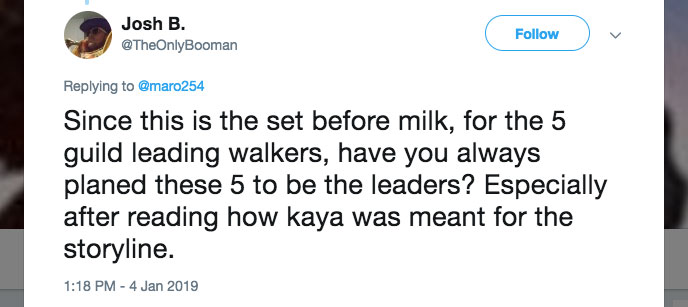
The entire Bolas Arc (Kaladesh through War of the Spark) was designed as one long story from the very beginning. Many things changed along the way (Kaladesh and Amonkhet were originally swapped, for example), but the finale was always planned for Ravnica, and the idea of five of the guilds falling to Bolas was also very early. Both Kaya and Dovin were originally created with their ultimate role in Ravnica in mind. (Vraska, Domri, and Ral were already Planeswalkers from Ravnica.) We knew the five Bolas guilds remarkably early on compared to most story elements.
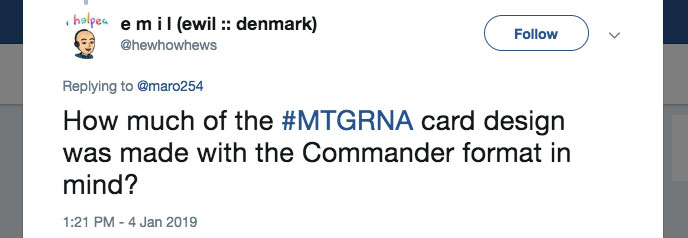
For most Magic formats, making cool, exciting Magic cards gets the job done. Ravnica has ten guilds. If we design each guild to maximize its feel and give a few new tweaks and twists, players will find new cards to play with. For Commander specifically, we kept an eye on the legendary creatures. Not all of them are designed to maximize Commander (as there are fans of legendary creatures other than Commander players), but most of them were. As I explained above, we're also always looking for ways to expand the colors (white and red) that have proven problematic for Commander in the past. Other than that, we're just making a cool set. That tends to make Commander players happy.
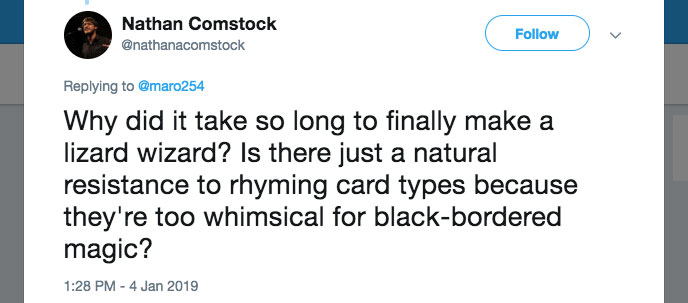
Magic turned 25 last year. That means whenever we do something for the first time, I get an email about why it took so long for "Thing X" to happen. Here's the answer I normally give:
#1 – There Are a Lot of Things That Can Happen
There's this phenomenon that I've heard called the soulmate bias. You get together with someone and then when you look back at all the things that had to happen for the two of you to actually get together, it seems daunting. What were the odds that all those individual things came to pass? Meanwhile, people meet and get together constantly. People meeting is not at all uncommon. It's just this perspective that makes it feel daunting. The same is true with Magic design. Only looking back through the lens of a single design does it look so daunting that it didn't happen. Another way to think of this is there were millions of things we potentially could design. Doing all of them in only 25 years is unlikely.
#2 – Us Designing Something and It Seeing Print Are Very Different
How did it take 25 years to design a Lizard Wizard? It didn't. I've designed loads of them. They just never made it through the gauntlet to print before. The idea that something didn't happen because no one ever thought of it often isn't the case.
#3 – Some Things Require Very Specific Circumstances
A Lizard Wizard requires there being a humanoid Lizard creature that's capable of performing a specific function, in this case casting magical spells. Also, Lizards tend to be red and green, and, more often, the magic casters in those colors are Shaman or Druids. The rhyming wasn't an issue—we do cutesy things often—rather the circumstances where we wanted a Lizard that was a Wizard just doesn't happen all that often.
So, no great conspiracy. It's just how circumstance works.

One of the challenges of returning to worlds is finding the right balance between bringing back things players associate with the world and finding new things to explore. As this was the third return to Ravnica, we had two previous trips to mine. That's a lot of material. Return to Ravnica block did have guild Charms. Original Ravnica block didn't, but on the return, I talked R&D into including them. I enjoy taking popular Magic conventions and adding the lens of the guilds.
The reasons we didn't do gold Charms again were a) we'd already done them, so it was an itch we'd scratched already, and b) we didn't have a new take on them. A cycle of ten charms requires 30 abilities, meaning we'd already hit upon most of the effects we'd want to use. Trying to do it again while not just recreating what we'd done in Return to Ravnica block would be a complicated task, one for which I don't believe there would be a good answer. So, we chose not to do them again.
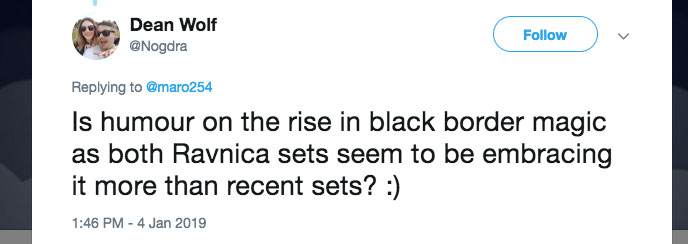
Humor in flavor text is definitely something that's done a lot of ebbing and flowing over the years. Back when I was more involved in flavor text, we tended to do a lot more humorous pieces. We then had a long stretch where there was more focus on tone and story and less on humor. I do think humor is making another upswing. If this is an aspect you enjoy, please let us know because it will increase the chances of doing more humor overall.
The Final Answer
And that's all the time I have for today to answer questions. As always, I'm interested to hear your thoughts on any of my answers or today's column in general. You can email me or contact me through any of my social media accounts (Twitter, Tumblr, Instagram, and Google+).
Join me next week for this year's "Nuts & Bolts" column.
Until then, keep asking questions. They often will lead to interesting places.
#607: Unique Creature Types
#607: Unique Creature Types
43:13
In this podcast, I examine the many creature types that are unique to the game of Magic.
#608: Other People's Lessons – Poetry
#608: Other People's Lessons – Poetry
40:43
This is a new series called "Other People's Lessons" where I look at lessons from other areas of art and examine how those lessons apply to Magic design. Today's lesson was by a poet named Kara Ziehl and talks about how to better write poetry.
- Episode 606 Lessons Learned – Dominaria
- Episode 605 Market Research
- Episode 604 Designing Counterspells

